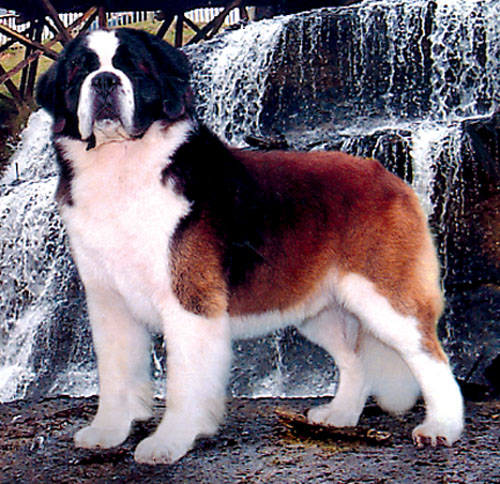
|

|

Shrouded in legend and the mists of time, the origin of the Saint Bernard is subject to many theories.
It seems
most probable that the Saint Bernard developed from stock that resulted from the breeding of heavy Asian "Molosser" (Canis
molossus), brought to Helvetia (Switzerland) by Roman armies during the first two centuries A.D., with native dogs which
undoubtedly existed in the region at the time of the Roman invasions.
During the following centuries, these dogs were
widely used in the valley farms and Alpine dairies for a variety of guarding, herding, and drafting duties. Referred to as
Talhund (Valley Dog) or Bauernhund (Farm Dog), they were apparently well established by A.D. 1050, when
Archdeacon Bernard de Menthon founded the famous Hospice in the Swiss Alps as a refuge for travelers crossing the treacherous
passes between Switzerland and Italy.
Just when dogs were first brought to the Hospice is debatable, since the Hospice
was destroyed by fire in the late 16th century, and, soon after, a large part of the Hospice archives were lost. The first
notation concerning the dogs was not until 1707. This, however, was merely a casual reference to dogs at the Hospice and carried
the implication that their rescue work at the Saint Bernard Pass was a fact well known at the time. From a digest of early
references, it appears that the dogs were first brought to the Hospice sometime between 1660 and 1670. It is likely that large
dogs were recruited from the valley areas below to serve as watchdogs for the Hospice and companions for the Monks during
the long winter months when the Hospice was almost completely isolated.
This isolation of the Hospice no doubt resulted
in inbreeding of the original stock which soon produced the distinctive strain of "Hospice Dog." It also follows that only
those animals with the strongest instincts for survival in the extremely adverse conditions at the Hospice were to leave their
genetic imprint upon the breed during those early years.
The lonely Monks, who took the dogs along on their trips of
mercy, soon discovered the animals were excellent pathfinders in the drifting snow, and the dogs' highly developed sense of
smell made them invaluable in locating helpless persons overcome during storms. Thus began this working together of Monk and
dog which made many of the world's most romantic pages of canine history.
During the three centuries that Saint Bernards
have been used in rescue work at the Hospice, it is estimated that they have been responsible for the saving of well over
2,000 human lives. Although the building of railroad tunnels through the Alps has lessened foot and vehicular travel across
the Saint Bernard Pass, the Monks have continued to maintain these fine dogs for companionship and in the honor of the Hospice
tradition.
|

|

|

